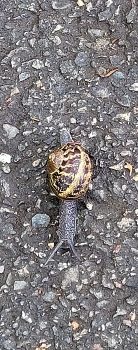Adam Yamey's Blog: YAMEY, page 48
June 22, 2024
A small garden in London’s Lambeth next to a museum of gardens
THE GARDEN MUSEUM is next door to London’s Tudor Lambeth Palace and close to Lambeth Bridge. The museum has its own gardens – one within an enclosed courtyard, and the other, containing several glasshouses, outside the museum. Next to the latter, there is yet another garden, the St Mary’s Gardens. This slender garden, filled with a wonderful range of flowering plants, was created in 1932, and improved considerably in 2008.
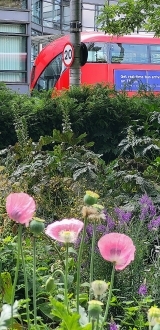
In the centre of this almost rectangular garden there is a circular water feature, decorated with mosaics. This is surrounded by several smaller mosaics, each one depicting fruits and animals. From the northern end of the garden, you can catch glimpses of the Houses of Parliament and the towers associated with them.
Flanked by the busy Lambeth Road that leads to Lambeth Bridge, this garden is a pleasant oasis in one of the most traffic-infested parts of London.
June 21, 2024
A walk in Lambeth’s Old Paradise Gardens
WHENEVER WE VISIT the Newport Street Gallery in London’s Lambeth district, we pass the entrance to a small garden. Today (19th of June 2024), we decided to enter this little park – a peaceful haven only a few hundred yards south of Lambeth Bridge. It is called Old Paradise Gardens. Irregular in shape, it has one long main path leading from its northern entrance in a southeasterly direction towards its southern entrance, close to a busy railway line. Near the northern entrance, there is a small fenced off area, which is being developed as a community garden in collaboration with the nearby Garden Museum (next door to Lambeth Palace). Not being botanically knowledgeable, I cannot describe the wide variety of plants growing in the Gardens, but I can say that they make for an extremely pleasant green environment.
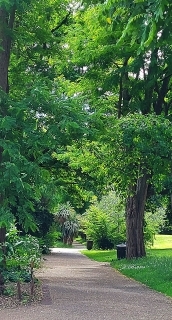
We saw a few worn, illegible tombstones propped up against one of the garden’s walls. These provide an important clue about the history of the Gardens. The place was:
“…previously a burial ground provided to the parish by the Archbishop of Canterbury in 1703. It was extended in 1816, but by 1853 was full and closed to burial. In 1880 it was decided to convert it into a public garden, which opened in 1884. Gravestones were moved to boundary walls … The recreation ground was extended in 1929 and by the 1970s was largely asphalted. Since re-landscaped, it has grassy mounds, a water feature, with shrubs and spring bulbs planted. In 2013 refurbishment was completed and the park was renamed Old Paradise Gardens. In 2023 a new community garden was introduced in the southeast corner designed by Dan Pearson Studios under the leadership of The Garden Museum nearby.” ()
When we visited the Gardens at about 11 am today, we saw few other people. Probably, at weekends and after school is over, this delightful little open space becomes busier. It is always lovely to ‘discover’ yet another of London’s numerous green spaces – about 40% of London’s area is occupied by public green spaces.
If you happen to be in need of refreshment whilst visiting the Old Paradise Gardens, head for the elegant café attached to the nearby Garden Museum.
June 20, 2024
Hanging on the walls at a house in Hammersmith
FACING THE THAMES near to The Dove pub in Hammersmith, there is an interesting little museum dedicated to exhibits relating to William Morris. In my book “BEYOND MARYLEBONE AND MAYFAIR: EXPLORING WEST LONDON”, I wrote about the museum as follows:
“ … Kelmscott House. Built on the site of an old warehouse, this became the home of Sir Francis Ronalds (1788-1873) in the early 19th century. Sir Francis, an inventor, laid eight miles of insulated electrical cable in the house’s extensive garden, which in his time stretched as far inland as King Street, and with that he demonstrated the use of telegraphy for the first time in history in 1816. When he reported his discovery to Lord Melville, the First Lord of The Admiralty, he was told (by Melville) that telegraphs were totally unnecessary, because the semaphore did the job of communication just as well.
In 1878, Ronalds’s house, known then as ‘The Retreat’, was bought by the writer and artist William Morris (1834-1896), who was a leading exponent of the Arts and Crafts Movement and a social reformer. According to his biographer Fiona MacCarthy, Morris did not like its name because ‘Retreat’ suggested that it might be regarded as an asylum. So, he renamed it Kelmscott House (the name of Morris’s Thames side dwelling in Oxfordshire).”
I wrote that the museum is housed in the:
“… long narrow coach house attached to the west side of Kelmscott House which was used as a lecture hall in William Morris’s time. It hosted many meetings of groups sympathetic to socialism, including one that which Morris joined in 1883: the ‘Democratic Federation’, later known as the ‘Social Democratic Federation’. Like some of today’s leading British socialists, Morris was also far wealthier than the people whom he hoped to help with his left-wing political sympathies.
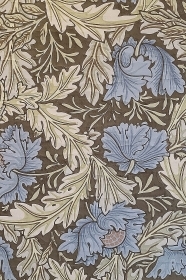
Today, the coach house, which bears a plaque in memory of Sir Francis Ronalds, houses the offices of the William Morris Society and a small museum.”
Recently (June 2024), we visited the museum, which has a temporary exhibition called “The Art of Wallpaper: Morris & Co. in Context”. It will remain in place until the 11th of August 2024. According to the museum’s website (https://williammorrissociety.org/whats-on/):
“This exhibition focuses on William Morris (1834–1896), placing his wallpaper designs within the context of the radical changes in taste witnessed during the Victorian era. His distinctive patterning is set against a backdrop of the fanciful, naturalistic patterns that typified fashionable English and French papers in Morris’s youth.”
The visitor can admire a collection of framed, highly decorative wallpaper samples, including many designed by Morris and his associates. Apart from the Morris designed wall papers, there are examples of styles that were fashionable in the 19th century: French style, Reform Movement Styles (e.g., by Pugin), Japanese-influenced designs, and the Arts and Crafts Movement. The most interesting exhibit was a wooden printing block, which would have been carefully inked up in different colours, and used to create the wall papers. Next to this, there were a couple of pages from the Morris logbook used to record the colours and designs of the papers produced by Morris and his company.
The small museum is well worth a visit. It is a shame that the main house to which it is attached is not open to the public at present.
PS The book is available as a paperback and a Kindle from AMAZON
June 19, 2024
A good film about the Holocaust in Poland
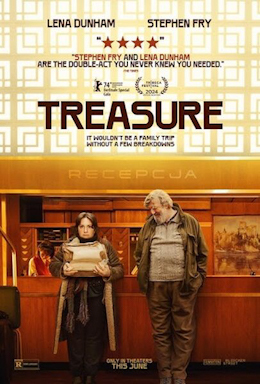
Set in about 1991, this recently made (2024) film, “Treasure”, is about a Ho;ocaust survivor, played by Stephen Fry, returning to visit Poland to re-visit where he was born and. then later interned (in Auschwitz). He travels with his 36 year old daughter, played by Lena Dunham. In brief, this film covers many aspects of the annihilation of Jews in Poland in a profound way, but with a delicate touch. The portrayal of a visit to the remains of the concentration camp at Auschwitz was handled beautifully – deeply moving but intelligently handled.
Stephen Fry is excellent in the film. His Polish/English accent reminded me of that of a Holocaust survivor, K, whom I knew well. Although I never knew what K was thinking deep down inside him, some of his behavioural aspects were portrayed well by Fry. The character played by Fry adapts well to his return to the town where he was born and the camp where he last saw his parents. The survivor played by Fry brought back many memories of my friend K.
The other actors in the film were very good, but Fry’s performance was outstanding.
A few months ago, I watched another Holocaust themed film, “Zone of Interest”, which in many ways failed to impress me. “Treasure”, on the other hand, is very good both in what it covers and how it achieves that.
June 18, 2024
A bird of peace above a hearth in Hammersmith
AFTER WATCHING A superb play, “Moffie” (a one man show about homosexuality in apartheid South Africa), at the Riverside Studios in London’s Hammersmith, we visited the nearby William Morris Museum, and then retired to its close neighbour, The Dove pub. This quaint little hostelry has a riverside terrace and the shortest bar counter in England. There has been a pub on its site since the 17th century. At one time, it was also a coffee house. The present building, whose interior is rich in timber beams, dates from the 18th century.
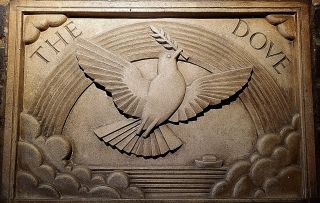
Being a sunny Sunday afternoon, the riverside terrace was full when we arrived at the pub. So, we found seats in the room with the short bar at the front of the pub. It was while we were enjoying our refreshments that I noticed a lovely white carving on the chimney breast above the fireplace – its style reminded me a little of the work of Eric Gill. Near to the carving there was a framed notice that provided the following information:
“As a result of old age and Hitler, this fireplace had to be re-built in 1948. It was re-built by Mr Ward of Barnes, in Elizabethan bricks, from a design by Mr Reece A.R.I.B.A.
The plaque was sculpted in white Portland stone by Ian Coleman, from a design prepared by John Worsley, after a woodcut in the possession of the landlord”
I have no idea about the woodcut that the landlord possessed, but I can tell you that John Worsley lived from 1919-2000. He painted at least one view of Hammersmith Bridge from a viewpoint close to The Dove – in 1948 (www.orleanshousegallery.org/collection/boat-race-hammersmith-bridge/). As for Ian Coleman, I cannot find any references to an artist with this name, who would have been alive in the late 1940s.
The fireplace alone is of interest, but there are also many other artworks – paintings and old photographs – that can be viewed in this delightful pub.
June 17, 2024
A builder cast in metal in London’s Pimlico near the Albanian embassy
THE ALBANIAN EMBASSY is on St Georges Drive in London’s Pimlico. On our way there we passed a statue that stands on a triangular plot where St Georges Drive meets Denbigh Street at an acute angle. The statue commemorates Thomas Cubitt (1788-1855), who was born in Norfolk and died in Surrey. It was created in 1995 by William Fawke (1948-2018).
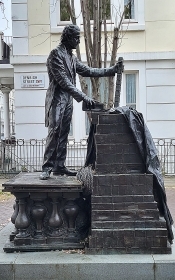
The metal sculpture depicts Cubitt standing on a platform facing a pile of building bricks. In his left hand, he holds a long, notched stick – a brick measure. The platform upon which he stands is supported by balustrade bottles (‘balusters’) that are used to support the railing that rests upon them. The bottles supporting Cubitt are the type found on the houses built by Cubitt.
Cubitt was the son of a carpenter. During his trip to India as a ship’s carpenter, Thomas earned sufficient money to be able to establish a building business in London’s Holborn. In cooperation with his younger brothers, William and Lewis (who designed Kings Cross station), his firm took off. He was an excellent organiser, and created teams of builders that included every branch of the trade. Some of his projects are listed in an interesting web page (https://victorianweb.org/art/architecture/cubitt/bio.html):
“By now he was a close friend of the royal family, having collaborated with Prince Albert on the design for Osborne House, which he then built for him. He also won the contract to extend Buckingham Palace, and it was Cubitt as well who orchestrated the dismantling of Nash’s Marble Arch there, and its reassembly at Hyde Park, ready for the Great Exhibition. The Exhibition itself was a project suggested to Prince Albert by Cubitt, after a conversation with a friend who had recently visited an exhibition in Paris. From 1839 Cubitt was an active member of the Institution of Civil Engineers; he was a leading figure in the campaigns for a main drainage system and a more extensive Thames Embankment, and rooted for limiting smoke emissions and conserving open space: Battersea Park owes its existence largely to him.”
In addition to this and other major projects, he built much of Tavistock Square and great swathes of housing in Pimlico. So, it is fitting that his statue has placed in the midst of the houses which his firm created in Pimlico. It was interesting to ‘discover’ the statue of Cubitt shortly before we entered the embassy which is housed in one of the houses he built in Pimlico.
June 16, 2024
Inverted images by an artist born in Germany at a gallery in London
CERTAIN IMAGES IMMEDIATELY come to mind when the names of some artists are mentioned. For Vincent Van Gogh it is sunflowers; for Claude Monet it is waterlilies; for Salvador Dali it is melting clocks; and for Edvard Munch it is “The Scream”. In the case of the German artist Georg Baselitz (born as ‘Hans-Georg Kern’ in Deutschbaselitz, Saxony, Germany in1938), mentioning his name conjures up inverted images: paintings in which the images appear to be upside down. He signs them with his signature, but it is not upside down.

Recently, we viewed an exhibition of this octogenarian’s latest paintings at the White Cube Gallery in London’s Bermondsey Street. The show is on until the 16th of June 2024. If you miss it, you will not have missed much worth seeing. As you can tell, I was not over-impressed by what I saw, but it did get me thinking about why the artist often chooses to paint his subjects – human and others – upside down.
Does he choose to do this because his childhood in Germany was spent in a country that had been turned upside down by the Nazi regime, the 2nd World War, and its immediate aftermath in the early years of the German Democratic Republic? The White Cube website quotes the artist as having said:
“I’ve got my early childhood drawings of eagles, stags, deer, dogs and so on in folders,’ Baselitz remarks. ‘Every now and then I look at them, and I think was it a good time, was it a bad time?”
Or does he paint his images upside down to attract the viewer – to make his artwork ‘stand out from the crowd’? Alternatively, does he invert his images so that the viewer is forced to consider not only the subject matter, but also his painting techniques (brush strokes, colour choices, and so on)?
I do not know the answers to these questions. However, I am glad I have seen the exhibition, which did not particularly thrill me, because it did stimulate me to consider his art a little more that I had expected.
June 15, 2024
An almost hidden treasure on London’s Hampstead Heath
ANYONE TRAVELLING BY ROAD along North End Way between Hampstead’s Whitestone Pond and Golders Green will pass Inverforth House (on the west side of the road). Now used as a luxury apartment house, the place has an interesting history and an even more interesting garden, some of which is open to the public.
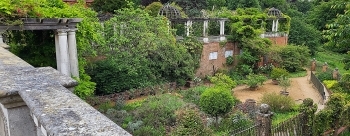
Here is what I wrote about this property in my book “Beneath a Wide Sky: Hampstead and its Environs” (available from Amazon):
“Inverforth Close, a small private road open to pedestrians, leads off North End Way. At the end of it, there is a delightful garden with a wooden pergola, The Hill Garden, which is open to the public. It was once part of the gardens of Inverforth House. The present house was built in 1895 in a ‘neo-Georgian’ style to the designs of the architectural practice of Grayson and Ould. Between 1896 and 1904, Ronald Fisher (1890-1962) lived there as a child. He was one of the ‘fathers’ of modern biological statistics.
Between 1904 and 1925, the house was owned by William Lever, Viscount Leverhulme (1851-1925). He was one of the first men to produce soap on an industrial scale (in 1884) and was an enlightened industrialist. He built Port Sunlight near to Birkenhead to house his workers in pleasant surroundings. The house’s library was designed by built by William and Segar Owen of Warrington, who also designed buildings at Port Sunlight. In 1955, Inverforth House became a convalescent home of the (now closed) Manor House Hospital, and that is how I remember it from my childhood. The hospital was not part of the NHS. It was privately run by trade unions. The edifice ceased being a hospital in 1999. Now, the house contains privately owned, luxury flats; it has become a ‘gated community’.
The gardens of Inverforth House were laid out from 1906 onwards by Thomas Hayton Mawson (1861-1933), garden designer, landscape architect, and town planner. According to one source (www.historic-uk.com), Lord Leverhulme wanted the pergola:
‘…to be the setting for extravagant Edwardian Garden parties, while at the same time being a place where his family and friends could spend long summer evenings enjoying the spectacular gardens.’
In 1960, the London County Council (‘LCC’) bought the Pergola and associated garden areas, which had by then become very dilapidated. In 1963, part of the gardens was opened to the public, and called the ‘Hill Garden’…”
Today, the 12th of June 2024, we re-visited the pergola. We had not been there for at least 10 years. Most of the long pergola (about 300 yards in length) was open to the public – more than in the past, it seemed to us. Although some of the timber trellising, which is supported by stone pillars, was looking rather weatherbeaten, walking along the raised paths was a delight because of the flowering bushes blooming all along it. From the pathway, one gets good views over Hampstead Heath and into the well-manicured private grounds of Inverforth House.
Many locals and people who used to be locals in Hampstead and Golders Green know about the Pergola and the Hill Garden next to it. However, when you reach it, you are sure to get the pleasurable feeling that you have discovered a secret garden, and unless you suffer from hay fever (and have not taken antihistamines), a wonderful experience awaits you.
June 14, 2024
The shell that moves
June 13, 2024
Tasty molluscs from an island off the coast of Essex
SOME PEOPLE SAY that the Ancient Romans in Rome enjoyed consuming oysters that had been harvested along the coast of Essex. It is said that these tasty molluscs were transported live from Essex to ancient Rome. A website (www.bbc.co.uk/news/uk-england-humber-69051462) noted:
“Oysters were highly prized by the Romans with some reports suggesting they played a key part in Julius Caesar’s decision to invade the British Isles. Many of the oysters were exported to Italy with Roman Emperors reportedly paying for them by their weight in gold.”
This quote refers to finding a Roman oyster processing site on the Humber estuary. Other places where oysters are cultivated include parts of the coast of Essex. These places are famous for the quality of their oysters. One of them is West Mersea on the island of Mersea, a few miles south of the city of Colchester. Today, this place is an important source of oysters. The gardens of houses in West Mersea are full of discarded oyster shells, both for decorative purposes and as a ground covering.
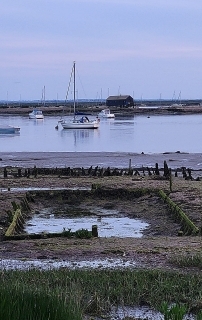
An oyster pit and the Packing Shed (in the distance)
Oysters are ideally cultivated in the brackish saline waters of estuaries. They feed by siphoning a large amount of seawater through their bodies, extracting nutrients from it. Sometimes, they collect sand and other impurities as the water passes through them. West Mersea sits at the mouth of the Blackwater River, and oysters have been grown and harvested there since Roman times. When oysters are mature enough to be harvested, they are placed in tanks filled with clean water which passes through them as they filter the water. This ensures that by the time they are sent to market, impurities such as sand have been removed from their digestive systems. Today, this purification process is carried out in sophisticated mechanised tanks, some of which irradiate the water with ultra-violet light to kill microbes. In the past, after being sorted for size, they were placed in wood-lined tanks filled with clean water. The remains of some of these now disused oyster pits can be seen rotting along the coastline at West Mersea.
In about 1890, a shed, now known as the ‘Packing Shed’, was constructed on an islet close to West Mersea. This building was built to be used for cleaning and sorting oysters before they were sent to destinations all over the world. Soon after it was built, it was blown away in a storm. In 1897, it was replaced by a new building, which remained in use until the 1950s. After that, it was hardly used and began to rot. Despite this, it survived the great storm of 1987. It became a picturesque ruin until 1992, when it was fully restored. Owned by the Tollesbury & Mersea Native Oyster Fishery Company, it is rented to the Packing Shed Trust, which uses it for a variety of purposes (including bird watching, weddings, art classes, parties, and celebrating special occasions). You can see this long, low building from many points on the seashore of West Mersea. On the day we were in West Mersea, we saw groups of young school pupils going on an excursion to visit the Packing Shed.
Several companies dealing in oyster cultivation and sales have sheds in West Mersea. There are plenty of eateries where you can sample these highly prized delicacies. We used to enjoy consuming them in the past before one of us had an extremely unpleasant reaction after eating some oysters at a good restaurant in London’s Kensington. The reaction was so bad that hospitalization was necessary. After that, both of us have, reluctantly, decided not to eat oysters again. Regardless of that, West Mersea is a delightfully peaceful place to visit – providing it is during school term time. We were told that during school holidays, Mersea Island becomes overcrowded and far from relaxing.

